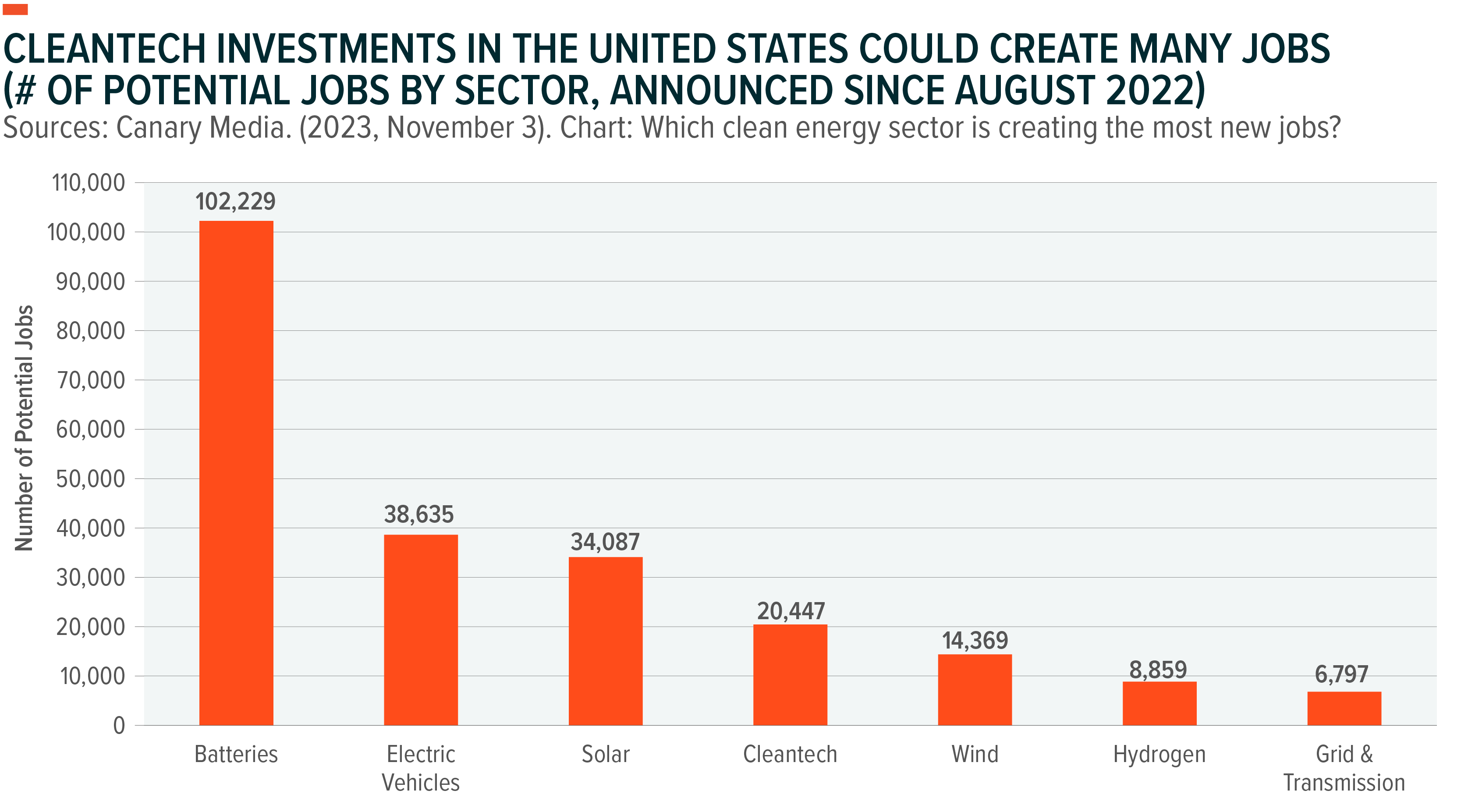All opinions expressed by Katherine Hamilton are solely hers and may or may not reflect opinions and beliefs of Global X ETFs.
Global X ETFs’ Research Team partnered with handpicked experts to explore the depth of changes from the disruptive technologies featured in this year’s iteration of our flagship research piece, Charting Disruption. Below, we discuss the most promising technologies and solutions for mitigating climate change with Katherine Hamilton. Katherine is Chair of 38 North Solutions, a clean energy and technology consulting firm. She is a global policy and technology thought leader, having most recently been named one of the 500 most influential people in Washington, DC, by Washingtonian magazine.1 She is also a regular contributor to The Carbon Copy podcast.
1. Global consensus is that we need to limit warming to 1.5°C to 2°C to avoid the worst impacts of climate change. What does the world need to do to successfully limit warming?
The world must collectively stop producing greenhouse gas emissions to avoid the worst impacts of the climate crisis. Arguably, we are even now starting to experience those impacts. In order to mitigate risks, we will need to transition our end uses to electric technologies and our generation resources to zero-carbon production, including through renewable energy. Additionally, we must make our homes, buildings, and processes more sustainable and efficient to reduce the amount of energy we need to run our economy. We should shift our transportation to all-electric and/or green hydrogen. And we have to mitigate effects on our natural habitats, including food production, with nature-based solutions.
Peer pressure is a giant lever, as evidenced by the Paris Agreement. As the COP28 came to an end in Dubai in mid-December, the final agreement was instructive on how, despite heavy lobbying by OPEC and for the first time in 28 years, nearly 200 countries collectively agreed on a transition away from fossil fuels.2 In addition, 123 countries signed the Global Renewables and Energy Efficiency Pledge, committing to triple installed renewable energy capacity by 2030 and double the global average annual rate of energy efficiency to 4% every year to 2030.3
2. How can government support, such as the Inflation Reduction Act in the United States, accelerate investments and growth into climate change technologies?
Governments can provide hard targets—such as renewable portfolio or clean energy standards—which have been used for years to set goals and continue to do so with state policy such as the Climate and Equitable Jobs Act in Illinois.4 Additionally, governments can provide grants and other funding tools, such as the Greenhouse Gas Reduction Fund in the Inflation Reduction Act (IRA), which offers affordable and accessible financing for clean energy projects in communities around the U.S., focused on disadvantaged areas.5 Finally, the government can institute tax credits for a wide variety of technologies to incentivize the market for clean energy and climate tech. In particular, the 10-year horizon for these tax credits in the Inflation Reduction Act is a game-changer for everything from energy storage to microgrids, hydrogen, and heat pumps, while continuing to support a steady market for solar and wind power.
3. Many manufacturers of wind and solar power system components, batteries, and EVs are expanding their manufacturing footprints in the United States. How can these investments encourage innovation and growth of these clean technologies?
The clean technology supply chain has been of enormous concern, in part triggered by the COVID-19 pandemic and the lack of ability to move products to where they were needed. The Inflation Reduction Act seeks to correct for those friction points by incentivizing manufacturing. Tax credits for project developers to source products domestically, as well as grants and credits for manufacturers to build plants in the U.S., have contributed to an incredible rise in plans to manufacture in the United States. Since the IRA’s passage in August 2022, 113 new clean energy manufacturing facilities in the wind, solar, and battery segments, totaling $408 billion in investments, have been announced.6 These investments, along with those in other technologies such as electric vehicles (EVs) and hydrogen, could create over 200,000 jobs.
As generation and storage technologies are deployed, knowing where they will be sourcing their modules, battery materials, etc. will be crucial as demand rises. And as manufacturing grows and jobs are created, regions can benefit economically with increased tax bases and, over time, the U.S. can begin to export not only our innovation and technology expertise, but also the very products that can provide climate solutions.

4. In your view, can the world reach net zero emissions by 2050 and what technologies hold the most promise for decarbonizing hard-to-abate activities, such as long-haul transport? What opportunities can the green transition create for companies?
I do believe the world can reach net zero emissions by 2050, but only with political will. We have most of the technologies now to produce and use energy with zero emissions, including wind, solar, geothermal, hydropower, and energy storage. Harder to abate sectors—such as industry, agriculture, and heavy duty-transportation—have technology-based solutions in development as well. In all of these sectors, electrification is becoming a more viable solution, as are hydrogen and other processes that use existing infrastructure but can transition feedstocks from fossil fuels to cleaner options. Climate tech experts point to “storage and grid management in the energy sector; recycling and low-carbon concrete and cement in industrials; and forestation and habitat restoration in carbon removal” as ways to support the green transition.7
Crucially, corporations must be part of the solution, and it also presents them with additional potential opportunities for growth. During COP28, fifty companies, which represent 40% of global oil production combined, committed to the goal of reaching net zero emissions by 2050.8 Furthermore, these companies, including major oil companies like ExxonMobil, Total, and Aramco, also pledged to reduce methane emissions to near zero and to invest in renewables and other zero-emission technologies.9
5. As we navigate the imperative transition to a sustainable future, we are increasingly confronted with concerns about energy security amid the potential for supply chain disruptions and escalating geopolitical tensions. These circumstances are sometimes perceived as detrimental to the clean energy transition. How can we effectively address these challenges to ensure a smooth and equitable transition to renewable energy sources, particularly given the critical role of international cooperation in tackling climate change?
The climate crisis is global and impacts every part of our lives—from working and driving to eating and breathing—so all our solutions must be seen as benefiting the whole, while also ensuring that nations, such as the U.S., build energy security into the equation. Reliance on any one source of energy is risky, as we know. The starkest example has been with coal, on which our industrial revolution was built and around which entire communities depended for jobs and economic prosperity. Now most of these communities are left with neither. Any transition to a new economic engine must take into consideration diversification of resources, a workforce to match the needs of the clean energy transition, and a sustainable path for communities to prosper.
Another example is the dependence of the EU on Russian gas to power their district heating. In both cases, the generation resource—whether solar, wind, or geothermal—must be considered as well as the demand side, given that electrification of end uses will be increasing. While the transition may not always be smooth, we should make certain that we do not lose sight of the need to bring everyone along, providing access to clean energy and food resources while also enabling an economically sustainable pathway. Six years ago, I wrote a piece on this topic for the World Economic Forum urging that we do not leave behind workers in fossil fuel industries as we transition; those sentiments are ever more important as the clean energy transition accelerates with policies such as the Inflation Reduction Act.10
 Madeline Ruid
Madeline Ruid